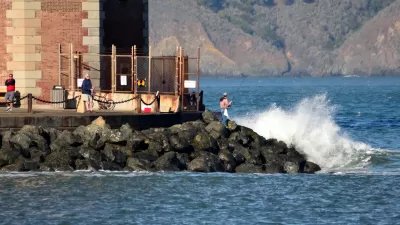Income inequality, housing affordability, and systemic racism join sea-level rise as key issues in Oakland's vision for urban resilience.

Like many resilience strategies, the Resilient Oakland Playbook outlines plans to prepare aging infrastructure for the drought conditions, increased wildfires, and sea-level rise that will likely impact the California city in the coming years.
But while climate impacts might be where some plans stop, Oakland has taken the approach that social and racial equity, an inclusive economy, and citizen empowerment are also crucial to the city’s overall sustainability.
"Our greatest barriers to resiliency are addressing our day-to-day social stresses, including equitable access to quality jobs, education, affordable housing, community safety and better infrastructure," Chief Resiliency Officer Kiran Jain told Next City.
Oakland does address these problems individually: The city has a goal of producing zero waste by 2020. It has taken steps to tackle its housing crisis, and recently launched its first Department of Transportation, which will take a complete streets approach to transportation planning. The state is also developing a regional plan to address sea-level rise in the Bay Area. The new "playbook" serves to connect separate departments under a common framework.
It is an element of the city’s participation in the Rockefeller Foundation’s 100 Resilient Cities (100RC) program, which provides cities worldwide technical support and funding for resiliency programs. Oakland hired its first chief resiliency officer through 100RC in 2014.
FULL STORY: Oakland Publishes Playbook for a Resilient Future

Planetizen Federal Action Tracker
A weekly monitor of how Trump’s orders and actions are impacting planners and planning in America.

Congressman Proposes Bill to Rename DC Metro “Trump Train”
The Make Autorail Great Again Act would withhold federal funding to the system until the Washington Metropolitan Area Transit Authority (WMATA), rebrands as the Washington Metropolitan Authority for Greater Access (WMAGA).

The Simple Legislative Tool Transforming Vacant Downtowns
In California, Michigan and Georgia, an easy win is bringing dollars — and delight — back to city centers.

The Small South Asian Republic Going all in on EVs
Thanks to one simple policy change less than five years ago, 65% of new cars in this Himalayan country are now electric.

DC Backpedals on Bike Lane Protection, Swaps Barriers for Paint
Citing aesthetic concerns, the city is removing the concrete barriers and flexposts that once separated Arizona Avenue cyclists from motor vehicles.

In These Cities, Most New Housing is Under 441 Square Feet
With loosened restrictions on “micro-housing,” tiny units now make up as much as 66% of newly constructed housing.
Urban Design for Planners 1: Software Tools
This six-course series explores essential urban design concepts using open source software and equips planners with the tools they need to participate fully in the urban design process.
Planning for Universal Design
Learn the tools for implementing Universal Design in planning regulations.
Smith Gee Studio
City of Charlotte
City of Camden Redevelopment Agency
City of Astoria
Transportation Research & Education Center (TREC) at Portland State University
US High Speed Rail Association
City of Camden Redevelopment Agency
Municipality of Princeton (NJ)




























